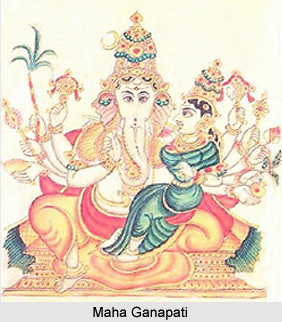 The legend of Maha Ganapati is mentioned in the Brahmanda Purana which is one of the eighteen Mahapuranas. It is believed that Lord Ganesha is to be worshipped first before adoring any other gods. The tale related to the emergence of Lord Maha Ganapati is narrated in the Brahmanda Purana under Sri Lalitopakhyana. The legend mentions that once Goddess Maha Tripura Sundari was engaged in a war with Bhandasura who was a demon created from the ashes of Kama Deva, the god of love. Dandanatha and goddess Bala Ambika also fought valiantly and eliminated around three hundred sons of the demon Bhandasura. Consequently, the commander of Bhandasura`s army, Visukra carved the Jayavighna yantra over a block of stone. Then he placed it in the camp of the army of goddess Maha Tripura Sundari.
The legend of Maha Ganapati is mentioned in the Brahmanda Purana which is one of the eighteen Mahapuranas. It is believed that Lord Ganesha is to be worshipped first before adoring any other gods. The tale related to the emergence of Lord Maha Ganapati is narrated in the Brahmanda Purana under Sri Lalitopakhyana. The legend mentions that once Goddess Maha Tripura Sundari was engaged in a war with Bhandasura who was a demon created from the ashes of Kama Deva, the god of love. Dandanatha and goddess Bala Ambika also fought valiantly and eliminated around three hundred sons of the demon Bhandasura. Consequently, the commander of Bhandasura`s army, Visukra carved the Jayavighna yantra over a block of stone. Then he placed it in the camp of the army of goddess Maha Tripura Sundari.
As a result of the influence of Jayavighna yantra, the army of the goddess became fatigued, forgetful and miserable and also became lazy. Moreover the divine army of Goddess Sri Lalita Devi (Maha Tripura Sundari) became dispirited due to the influence of the Jayavighna yantra. The soldiers threw away their weapons and retreated to their respective cantonments. At this point of time, the demon Visukra seized the divine weapons and used them to attack the warriors of the Goddess.
Dandanatha, the army commander of the goddess, and Sacikesani became quite alert at that point of time. They rushed to the Goddess in order to inform her about the latest situation of the war. Goddess Maha Tripura Sundari Lalita smiled after hearing the news. A smile appeared on the face of the great Goddess and lustre emerged from her face. It transformed into a male form with the head of an elephant. The male figure had the lustre of flowers all over his divine body. He possessed ten arms and carried a kamadalu of gems, a goad, ears of paddy, a lotus flower, a noose, a beautiful trident conch, bow of sugarcane, a mace or gada, the citron and some other objects. One of his hands displayed the Varada Mudra which is the boon granting hand gesture. An intoxicating sound emerged from the mouth of the elephant-headed deity. The divine being also embraced his consorts, Goddess Laksmi and Siddhi who appeared on either sides of the Lord. Thus Lord Ganesha or Maha Ganapati appeared to the Goddess Maha Tripura Sundari Lalita and bowed to her to receive her blessings.
Later Maha Ganapati went to the army camp of the goddess and discovered the Jayavighna yantra that was placed by the demon Visukra. The Lord destroyed the yantra with his own tusk. The army of the Goddess regained their will and defeated the demonic army of Bhandasura. Goddess Maha Tripura Sundari Lalita became pleased with Lord Ganesha and announced that the elephant-faced deity will be worshipped first before the commencement of any auspicious work or religious function.









